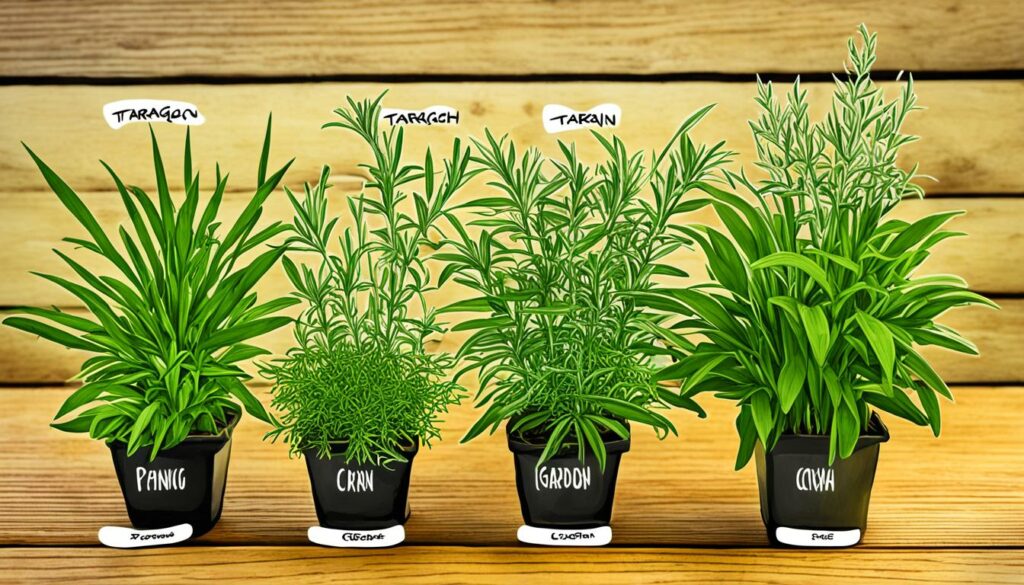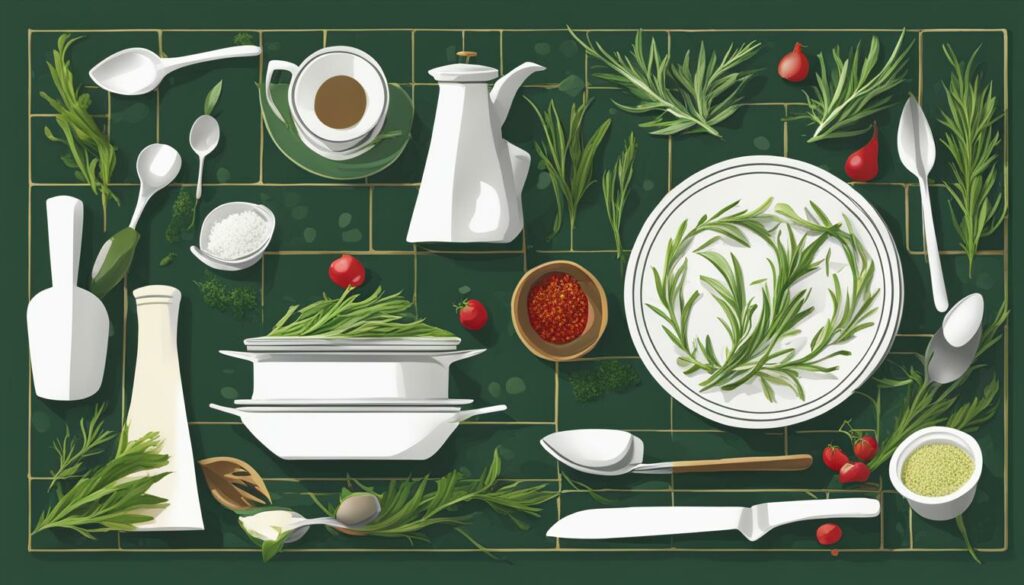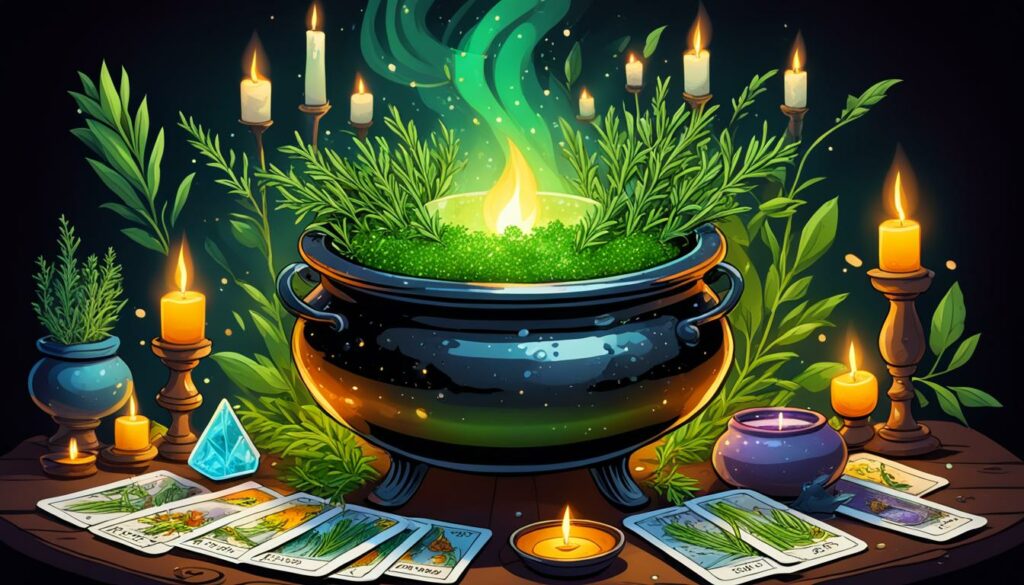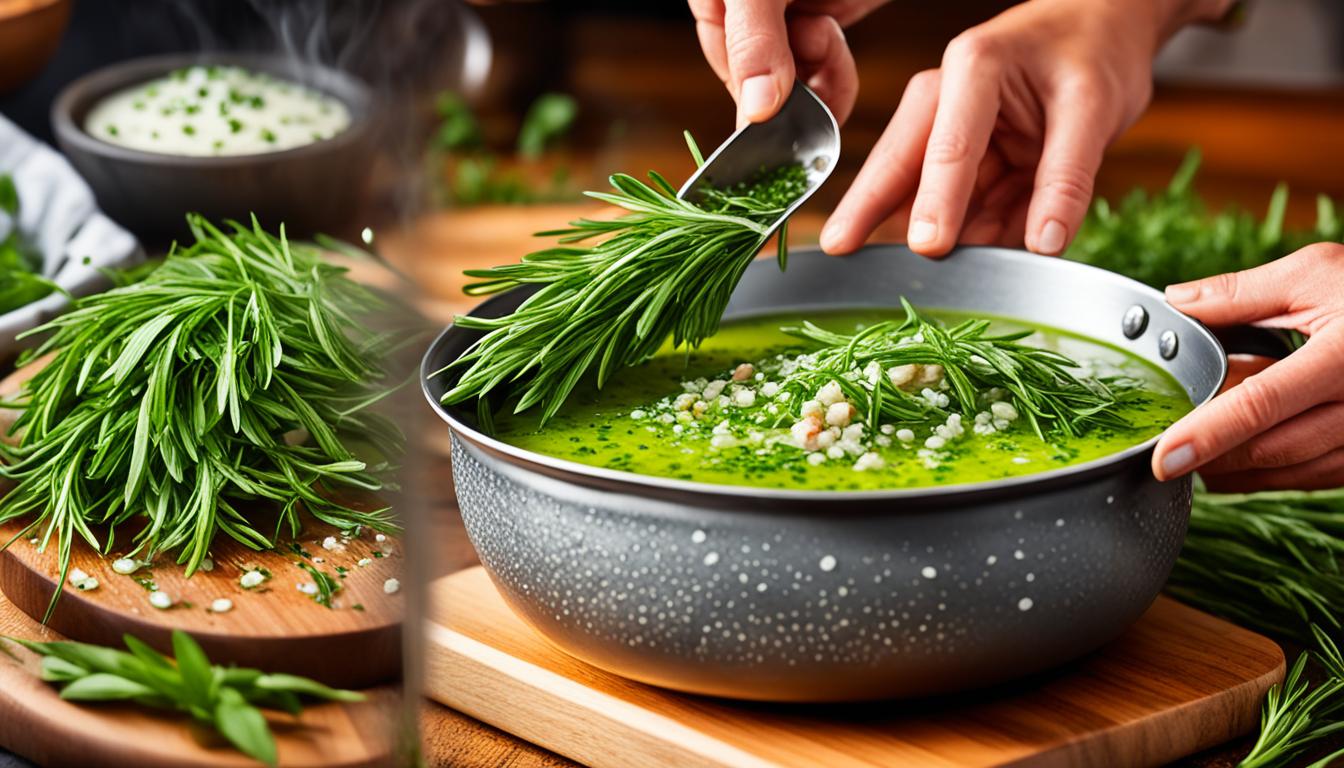Welcome to the world of tarragon, a flavorful herb with a rich history and a wide range of culinary uses. Known for its distinct licorice-like flavor, tarragon has been a staple in kitchens around the world for centuries. Whether you’re an experienced chef or a home cook looking to add some excitement to your dishes, tarragon is a must-have ingredient in your pantry.
When it comes to culinary uses, tarragon is incredibly versatile. It can enhance the flavors of poultry, fish, eggs, and vegetables, making it a perfect addition to various savory dishes. Tarragon pairs well with salads, dressings, and herb butters, adding a subtle yet distinctive touch to your creations. From classic French cuisine to international delicacies, tarragon has found its way into kitchens across the globe.
But tarragon’s uses go beyond the kitchen. This herb offers potential medicinal benefits, as it is rich in nutrients like vitamins A, C, and B-complex. It’s believed to ease digestive issues, promote sleep, and even soothe toothaches. Tarragon has also found a place in magical and spiritual practices, with associations of protection, courage, and passion.
Whether you’re exploring new recipes, embracing natural health remedies, or incorporating tarragon into your spiritual practices, this versatile herb is sure to elevate your culinary and personal experiences. Join us as we dive into the history, varieties, flavor profile, and more of this incredible herb.
The History and Origins of Tarragon
Tarragon, a beloved herb with a distinctive flavor and aroma, has a fascinating history that spans centuries. It is believed to have originated in Central Asia and made its way to Europe during the medieval period. However, it was in France during the 16th century that tarragon gained significant popularity and became a cherished ingredient in classic French cuisine.
The cultivation of tarragon has expanded beyond France and is now grown in various regions, including Russia and Mexico. Nevertheless, French tarragon remains highly regarded for its superior flavor and is widely favored by chefs and home cooks alike.
Understanding the history and origins of tarragon allows us to appreciate its cultural significance and its prominent role in culinary traditions. This herb’s journey from its Central Asian roots to becoming a beloved ingredient in French cuisine is a testament to its exceptional taste and versatility.

Understanding the Different Varieties of Tarragon
When it comes to tarragon, there are several varieties to explore, each with its own unique characteristics and culinary uses. Let’s take a closer look at the three most prominent varieties: French tarragon, Russian tarragon, and Mexican tarragon.
French Tarragon: The Epitome of Flavor
French tarragon, known as Artemisia dracunculus sativa, is hailed as the true and most flavorful variety of tarragon. It is considered a staple herb in classic French cuisine and imparts a delicate licorice-like flavor to dishes. With its slender, narrow leaves and intense aroma, French tarragon adds a touch of elegance to soups, sauces, and herb-infused butters.
Russian Tarragon: A Milder Alternative
Russian tarragon, scientifically referred to as Artemisia dracunculus inodora, offers a milder flavor compared to its French counterpart. While it lacks the intense aroma and distinct flavor of French tarragon, Russian tarragon has its own unique appeal. It is often described as slightly bitter and can be easier to propagate, making it a popular choice for home gardeners. However, it is important to note that Russian tarragon is not as desirable for culinary purposes due to its less pronounced flavor.
Mexican Tarragon: An Alluring Twist
Mexican tarragon, also known as Mexican mint marigold or Tagetes lucida, is not a true tarragon but offers a delightful alternative. With its sweeter taste and anise-like flavor, Mexican tarragon brings a touch of warmth to Mexican cuisine. It pairs well with seafood, poultry, and vegetables, adding a unique twist to traditional dishes like mole sauce and salsas.
While French tarragon remains the preferred choice for its aromatic intensity, Russian tarragon and Mexican tarragon offer their own distinct flavors and culinary applications. Whether you’re seeking the traditional essence of French cuisine or exploring new taste dimensions, the diverse varieties of tarragon open up a world of culinary possibilities.

Tarragon’s Flavor Profile and Culinary Uses
Tarragon, with its unique flavor profile, adds a delightful twist to a variety of dishes. Its flavor can be described as a combination of sweet, slightly bitter, and anise-like notes, creating a pleasant and aromatic experience for your taste buds. This herb is particularly well-suited for savory dishes and pairs beautifully with poultry, fish, and eggs.
In classic French cuisine, tarragon plays a starring role and is considered a key ingredient in many dishes. Its intense flavor enhances the taste of sauces, dressings, and marinades, giving them an added depth and complexity. Tarragon also brings a burst of freshness to vegetable dishes, elevating them to new heights of flavor.
When it comes to culinary uses, the possibilities are endless. Tarragon can be infused into oils, vinegars, and butters, creating a flavorful base for cooking and seasoning. Its vibrant taste also makes it a popular choice for salads, where it adds a refreshing and aromatic element.
To give you a better idea of the versatility of tarragon in the kitchen, here are some popular culinary uses:
- Chicken Tarragon: This classic dish features tender chicken cooked in a creamy tarragon-infused sauce, creating a harmonious blend of flavors.
- Béarnaise Sauce: Tarragon is a crucial ingredient in this iconic French sauce, known for its rich, creamy texture and tangy flavor.
- Herb Butters: Tarragon can be combined with other herbs and mixed into butter, creating a compound butter that adds a burst of flavor to grilled meats, steamed vegetables, or crusty bread.
- Salad Dressings: Tarragon-infused vinegar or oil can be used to create delicious dressings that brighten up any salad.
- Marinades: Tarragon is a fantastic addition to marinades for poultry, fish, or vegetables, infusing them with its unique flavor.
“Tarragon brings a burst of freshness to dishes, elevating them to new heights of flavor.”
The flavor profile of tarragon is truly remarkable, making it an indispensable herb in the culinary world. Whether you are preparing a classic French dish or experimenting with international flavors, tarragon adds a subtle yet distinctive touch that will impress your palate.

Tarragon in Classic French Cuisine
Tarragon holds a special place in classic French cuisine and is used in various iconic dishes. One popular dish that showcases the exquisite flavor of tarragon is Chicken Tarragon, also known as Poulet à l’Estragon. This delectable dish features tender chicken simmered in a creamy tarragon-infused sauce, creating a harmonious blend of flavors that is truly irresistible.

Another classic French sauce that incorporates tarragon is the famous Béarnaise sauce. This rich and velvety sauce combines the flavors of tarragon, shallots, vinegar, and butter, resulting in a sauce that is perfect for drizzling over grilled steak or roasted vegetables.
Tarragon is not limited to sauces alone; it also adds its unique touch to various other French dishes. It can be found in refreshing salads, where its bright and fresh flavor complements the crispness of the greens. Tarragon-infused dressings take salads to a whole new level, elevating the taste and making every bite a delight.
When it comes to herb-infused butters, tarragon takes center stage. Its distinct aroma and licorice-like flavor infuse the butter with an enchanting essence, creating a perfect accompaniment to bread, grilled meats, or roasted vegetables.
To summarize, tarragon adds a touch of elegance and sophistication to classic French cuisine. From creamy tarragon-infused sauces to refreshing salads and herb-infused butters, tarragon lends its unique flavor and aroma to create culinary masterpieces that are loved and celebrated worldwide.
Tarragon as a Medicinal Herb
In addition to its culinary uses, tarragon offers a range of medicinal properties that can benefit your health. This versatile herb is not only packed with flavor but also rich in nutrients, making it a valuable addition to your natural health regimen.
Rich in Nutrients: Tarragon is a nutritional powerhouse, containing vitamins A, C, and B-complex. These vitamins are essential for overall health and well-being. Vitamin A supports healthy vision, while vitamin C is an antioxidant that boosts the immune system. The B-complex vitamins contribute to energy production and brain function.
Digestive Benefits: Tarragon has long been used to stimulate the appetite and aid in digestion. It can help ease dyspepsia, a common condition characterized by discomfort and indigestion. Its natural compounds have soothing properties that can calm an upset stomach.
Promotes Sleep: Tarragon is believed to promote restful sleep. Its calming properties may help you relax and unwind, leading to a more peaceful night’s rest. Incorporating tarragon into your evening routine can support a healthy sleep cycle.
Potential Toothache Remedy: Tarragon has a numbing effect that may offer temporary relief from toothaches. Applying tarragon directly to the affected area can help alleviate pain and discomfort. However, it’s important to consult a dental professional for proper evaluation and treatment.
Whether you’re looking to improve digestion, enhance sleep quality, or seek temporary relief from toothaches, tarragon’s medicinal properties can offer natural support.

Discover the health benefits of tarragon and unlock its medicinal potential for a healthier, balanced lifestyle.
Growing and Cultivating Tarragon
If you’re an herb enthusiast or a culinary adventurer, growing tarragon in your own garden can be a rewarding experience. Not only will you have easy access to this versatile herb, but you’ll also be able to enjoy its fresh flavors in your favorite dishes. Whether you’re a beginner or an experienced gardener, here’s a simple guide on how to grow tarragon successfully.
Starting from Seed
The first step in growing tarragon is starting from seed. Begin by sowing the seeds indoors about six weeks before the last frost of spring. Fill a seed tray or pots with good-quality seed compost and sow the seeds at a depth of about ¼ inch. Keep the soil consistently moist and ensure that the tray or pots receive plenty of sunlight or use a grow light.
After the seeds have germinated, which usually takes about 7-14 days, thin them out, leaving only the strongest and healthiest seedlings. Continue to care for them indoors until the risk of frost has passed, and the seedlings are strong and ready for outdoor transplanting.
Transferring Outdoors
When the weather has warmed up and all chances of frost have passed, it’s time to transplant your tarragon seedlings outdoors. Choose a sunny spot in your garden or balcony, preferably with well-draining soil. Tarragon thrives in full sun, so ensure that the location receives at least six hours of sunlight each day.
Prepare the soil by removing any weeds or debris and add organic matter or compost to enrich the soil for optimal growth. Dig a hole slightly larger than the root ball of the seedling and place it in the hole. Gently pat the soil around the seedling to secure it, making sure it stands upright.
Water the newly transplanted tarragon thoroughly, ensuring that the soil is evenly moist. Avoid overwatering, as excessive moisture can lead to root rot. Water the plants regularly, especially during dry periods, but allow the soil to dry out slightly between waterings.
Caring for Tarragon Plants
Maintaining the health and vigor of your tarragon plants is crucial for a bountiful harvest. Here are a few care tips to keep in mind:
- Water the plants regularly, ensuring the soil remains evenly moist, but avoid waterlogging.
- Apply a layer of mulch around the base of the plants to help retain moisture and suppress weeds.
- Pinch back the growing tips regularly to encourage bushier growth.
- Remove any yellow or damaged leaves to maintain plant health.
- Harvest the leaves as needed, using sharp scissors or pruning shears. Cut them close to the stem to encourage new growth.
With proper care and attention, your tarragon plants will flourish, providing you with a continuous supply of this flavorful herb right at your fingertips.

Tarragon in Magic and Witchcraft
Tarragon holds an enchanting allure beyond its culinary and medicinal uses. With its mystical properties, tarragon has long been associated with magic and witchcraft. From protection spells to love rituals, tarragon is a herb that embodies both power and allure.
Tarragon’s Magical Properties:
- Protection: Tarragon is believed to possess protective energies. It can be used in spells, charms, or amulets to safeguard homes, loved ones, and oneself from negative energies.
- Courage: Tarragon is associated with courage and can be utilized to boost confidence during challenging situations. Whether you need an extra dose of bravery or assertiveness, tarragon can be your spiritual ally.
- Dream Work: Placing tarragon under your pillow is thought to enhance dream recall and facilitate lucid dreaming. It offers a gateway to explore the mysteries of the subconscious mind.
- Love and Lust: Tarragon possesses potent romantic energy. It can be incorporated into love spells and rituals to ignite passion, desire, and deepen connections with a loved one.
Immerse yourself in the world of magic and witchcraft by harnessing the mystical properties of tarragon. Let its enchanting essence guide you on a spellbinding journey.
“Tarragon, a herb of both protection and desire, weaves its enchantment through rituals and spells, empowering the practitioner with its mystical energies.”
Recommended Ritual:
- On a moonlit night, create a sacred space where you can perform your ritual undisturbed. Light candles and cleanse the area with sage or palo santo to purify the energy.
- Hold a sprig of fresh tarragon in your hands, feeling its vibrancy and connection to the elements.
- Focus your intentions on the specific magic you wish to manifest – whether it is protection, courage, dream work, love, or lust.
- Recite an incantation that resonates with your desires, infusing your words with passion and intention.
- Visualize the desired outcome as you place the tarragon in an amulet, charm bag, or sprinkle it around your sacred space.
- Express gratitude for the magical energies bestowed by tarragon and close your ritual with reverence.
Remember, magic is a personal journey, and your own belief and intention are essential in crafting powerful spells and rituals. Let the captivating essence of tarragon guide you as you explore the mystical realms of magic and witchcraft.

Tarragon’s Nutritional Benefits
Tarragon not only adds incredible flavor to your dishes but also provides a host of nutritional benefits. This versatile herb is a powerhouse of nutrients that contribute to your overall well-being. Whether you’re a culinary enthusiast or simply looking to improve your health, tarragon has got you covered.
Antioxidant-rich for Eye Health
One of the standout nutritional benefits of tarragon is its high antioxidant content. It contains essential antioxidants like beta-carotene and lutein, which play a crucial role in supporting eye health. These antioxidants help protect the eyes from oxidative damage and may reduce the risk of age-related eye diseases.
Heart and Kidney Health Booster
Tarragon is also a rich source of potassium, a mineral that is vital for maintaining heart and kidney health. Adequate potassium intake helps regulate blood pressure, support proper heart function, and promote healthy kidney function. By incorporating tarragon into your diet, you can give your cardiovascular and renal systems a natural boost.
Essential Nutrients for Red Blood Cells
Did you know that tarragon contains trace elements of iron? Iron is an essential mineral that plays a key role in the production of red blood cells, which transport oxygen throughout your body. Including tarragon in your meals can help ensure that you’re getting a sufficient supply of iron to support optimal blood oxygenation.
Traditional Digestive and Sleep Benefits
Tarragon is not just known for its culinary uses but also for its potential digestive benefits. It has a long history of use in traditional medicine to ease digestive issues and stimulate the appetite. Additionally, tarragon has been associated with sleep-promoting properties, helping you relax and improve your sleep quality naturally.
Incorporating tarragon into your diet is a flavorful way to reap its nutritional benefits. Whether you’re tossing it into a salad, adding it to a marinade, or infusing it into a sauce, this herb packs a nutritional punch.
Why not try this nutrient-packed recipe featuring tarragon?
Tarragon Chicken with Quinoa Salad
Serves: 4
Prep time: 15 minutes
Cook time: 25 minutes
Total time: 40 minutes
| Ingredients | Instructions |
|---|---|
|
|
Indulge in the delicious flavors of tarragon while nourishing your body with its impressive nutritional profile. From supporting eye health to promoting heart and kidney function, this versatile herb is a valuable addition to your kitchen and your overall well-being.

Conclusion
In conclusion, tarragon is a versatile herb that offers a wide range of uses in the culinary world and beyond. French tarragon, known for its intense flavor, is highly regarded as the go-to variety. However, Russian tarragon and Mexican tarragon have their own unique flavors that can add a distinctive touch to your dishes.
When it comes to cooking, tarragon can enhance the taste of savory dishes, sauces, dressings, and vegetable preparations. Its presence in classic French cuisine adds sophistication and depth to iconic dishes. But tarragon isn’t just limited to the kitchen.
Tarragon has also been used for centuries in medicinal practices, thanks to its potential digestive benefits and sleep-promoting properties. Additionally, tarragon holds spiritual and magical properties, making it a valuable herb for those exploring the world of witchcraft and magic.
Whether you’re preparing a gourmet meal or delving into the mystical realm, tarragon is an essential companion to elevate your culinary creations and add a touch of enchantment to your experiences.
FAQ
What are the culinary uses of tarragon?
Tarragon can enhance the flavors of poultry, fish, eggs, and vegetables. It pairs well with salads, dressings, and herb butters, making it a versatile herb in savory dishes.
What is the history and origin of tarragon?
Believed to have originated in Central Asia, tarragon made its way to Europe during the medieval period. It gained popularity in France during the 16th century and became a key ingredient in classic French cuisine.
What are the different varieties of tarragon?
Tarragon comes in French, Russian, and Mexican varieties. French tarragon is the most flavorful, Russian tarragon is bitter, and Mexican tarragon has a sweeter taste with an anise-like flavor.
What is the flavor profile of tarragon and how is it used in cooking?
Tarragon has sweet, slightly bitter, and anise-like notes. It pairs beautifully with poultry, fish, and eggs. Tarragon can be used to enhance the taste of sauces, dressings, marinades, and vegetable dishes.
How is tarragon used in classic French cuisine?
Tarragon is a key ingredient in dishes like Chicken Tarragon and Béarnaise sauce. It is also used in various other French dishes, including salads, dressings, and herb-infused butters.
What are the medicinal properties of tarragon?
Tarragon is rich in nutrients like vitamins A, C, and B-complex. It has been used to stimulate the appetite, ease dyspepsia, soothe an upset stomach, promote sleep, and potentially provide relief for toothaches.
How can tarragon be grown and cultivated?
Tarragon can be grown in pots from seed. It is best started indoors about six weeks before the last frost of spring. Tarragon prefers a sunny spot with well-draining soil, and with proper care, it can thrive and provide a fresh supply of this flavorful herb.
What are the magical properties of tarragon?
Tarragon is associated with protection, courage, dream work, love, and lust in magical practices. It can be used in protection spells, amulets, and rituals, boost confidence, aid in dream recall, and kindle passion and desire.
What are the nutritional benefits of tarragon?
Tarragon is packed with nutrients, including antioxidants like beta-carotene and lutein. It is a rich source of potassium and trace elements of iron, contributing to eye health, heart and kidney health, and red blood cell production.
How would you summarize the uses of tarragon?
Tarragon is a versatile herb with a wide range of culinary uses and health benefits. It is a staple in classic French cuisine, offers medicinal properties, and can be grown at home. In addition, tarragon has magical and nutritional benefits, making it a valuable herb in various aspects of life.
Source Links
- https://thecoventum.com/tarragon-101-a-guide-to-this-versatile-herb/
- https://www.savorysuitcase.com/how-to-use-tarragon-in-cooking/
- https://food52.com/blog/12703-fresh-tarragon-and-its-5-best-uses

